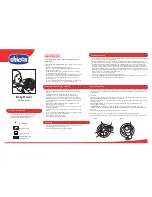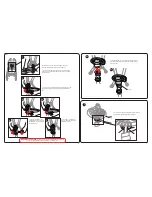
Baby Driver
Owner's Manual
IS0064E
©2011 Artsana USA, INC. 11/11
For your child’s safety. Please read these instructions and keep for
future reference.
WARNING
Cleaning
If you have any questions or comments about this
product, or are missing any of the parts, please
contact us in one of the following ways:
To prevent the risk of strangulation:
Do not attach strings or straps to
the toy.
• Toy must only be used under adult supervision.
• Remove and discard all packaging and packaging fasteners before
giving this toy to a child.
• Do not use the product if any components are broken or missing.
• Do not use this product on a car seat.
• Before each use, ensure that the product and all its components are
not damaged. If damaged or broken, immediately discard the toy.
• Do not use accessories or replacement parts other than those
approved by Chicco.
• Do not use if the attachment device installation interferes with the
proper use and adjustment of the strollers restraint system.
This product uses 2 AAA 1.5 volt batteries. Batteries must only be
fitted by an adult. Always keep batteries and tools out of reach of
children.
• To replace the batteries: loosen the screw on the battery
compartment cover (S, Fig. 2) with a Phillips screwdriver and
remove the battery cover. Insert the new batteries; checking to
make sure the polarity (+/-) on the batteries matches the markings
on the product. Replace the battery compartment cover and secure
with the screw.
• Always remove exhausted batteries from the product to avoid
damage by possible battery leakage.
• Always remove batteries when the product is not going to be used
for long periods of time.
• It is recommended to use alkaline batteries of the same type, in this
product.
• Do not mix alkaline, standard (carbon-zinc), or rechargeable (ni-cad)
batteries. Do not mix old and new batteries.
• Always dispose of batteries properly.
• Do not short circuit battery terminals.
@
(877)-424-4226
1826 William Penn Way
Lancaster, PA 17601
www.chiccousa.com
Removing and Inserting Batteries
• Clean the toy with a soft cloth. Do not submerge the toy in water to
avoid damaging the electronic circuit.
• Protect the toy against heat, dust, sand, and water.
Caution: changes or modifications not expressly approved by the part responsible for compliance could void
the user’s authority to operate the equipment.
NOTE: This equipment has been tested and found to comply with the limits for a Class B digital device,
pursuant to Part 15 of the FCC Rules. These limits are designed to provide reasonable protection against
harmful interference in a residential installation. This equipment generates, uses and can radiate radio
frequency energy and, if not installed and used in accordance with the instructions, may cause harmful
interference to radio communications. However, there is no guarantee that interference will not occur in
a particular installation. If this equipment does cause harmful interference to radio or television reception,
which can be determined by turning the equipment off and on, the user is encouraged to try to correct the
interference by one or more of the following measures:
- Reorient or relocate the receiving antenna.
- Increase the separation between the equipment and receiver.
- Connect the equipment into an outlet on a circuit different from that to which the receiver is connected.
- Consult the dealer or experienced radio/TV technician for help.
FCC Informations
S
R
Q
N
P
O
• Turn on the toy by moving the slider (N, Fig. 1) at the base of the steering wheel from the 0 (OFF) position to
the I (ON) position. Start up will be confirmed by a sound effect. From this moment, all electronic functions
will be enabled.
ACTIVITIES:
• BOOK: flipping through the pages of the little book (O, Fig. 1), the child will hear a melody and sound effect
which corresponds to the image displayed (police car, fire truck);
• HORN: when the child presses the horn (P, Fig. 1), a sound effect corresponding to the image displayed in the
book is produced.
• DIRECTIONAL SIGNALS: every time a directional signal is pressed (Q, Fig. 1) the child will hear the
corresponding sound effect;
• STEERING WHEEL: turning the steering wheel right or left, the child activates a melody. If the child
continues to turn the steering wheel while the melody is playing, different sound effects will be added to the
melody.
• KEY: when the key is turned (R, Fig. 1) a mechanical sound is activated.
Each activity, with the exception of turning the key, is accompanied by various lighting effects.
Always switch off the toy when it is not being used. Turn off the toy by moving the slider N to the 0 position.
Operating the Toy
Figure 1
Figure 2
For More Information


